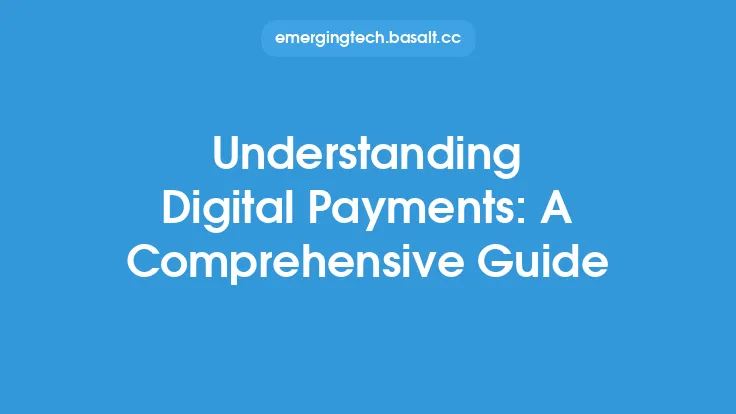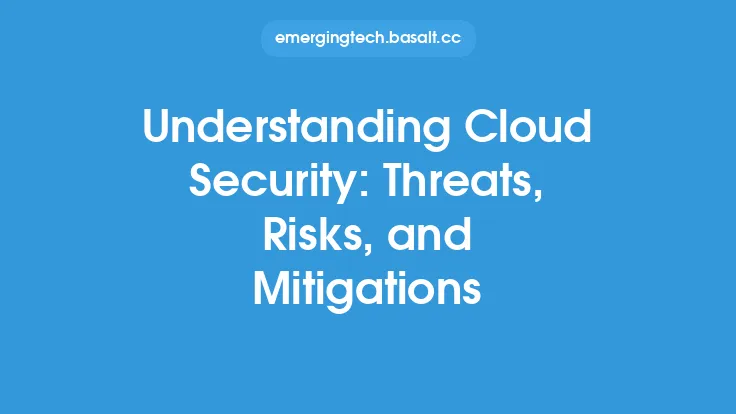The cloud computing landscape has undergone significant transformations over the years, with an increasing number of organizations adopting cloud services to enhance their operational efficiency, scalability, and cost-effectiveness. However, this shift towards cloud computing has also introduced new challenges, particularly with regards to compliance and regulatory requirements. As organizations move their data and applications to the cloud, they must ensure that they adhere to various laws, regulations, and standards that govern data privacy, security, and management. This article aims to provide a comprehensive guide to understanding cloud compliance, including the key regulations and standards that organizations must comply with.
Introduction to Cloud Compliance
Cloud compliance refers to the process of ensuring that an organization's cloud-based infrastructure, applications, and data adhere to relevant laws, regulations, and standards. This involves implementing controls, policies, and procedures to mitigate risks, protect sensitive data, and maintain the confidentiality, integrity, and availability of cloud-based resources. Cloud compliance is a critical aspect of cloud computing, as it helps organizations to avoid legal and financial repercussions, maintain customer trust, and protect their reputation.
Key Cloud Compliance Regulations and Standards
There are several regulations and standards that organizations must comply with when using cloud services. Some of the key regulations and standards include:
- General Data Protection Regulation (GDPR): The GDPR is a European Union regulation that governs the collection, storage, and processing of personal data. Cloud service providers must ensure that they comply with the GDPR's requirements for data protection, privacy, and security.
- Health Insurance Portability and Accountability Act (HIPAA): The HIPAA is a US regulation that governs the handling of protected health information (PHI). Cloud service providers that handle PHI must ensure that they comply with the HIPAA's requirements for data security, privacy, and breach notification.
- Payment Card Industry Data Security Standard (PCI DSS): The PCI DSS is a standard that governs the handling of payment card information. Cloud service providers that handle payment card information must ensure that they comply with the PCI DSS's requirements for data security, encryption, and access controls.
- International Organization for Standardization (ISO) 27001: The ISO 27001 is a standard that governs information security management. Cloud service providers that comply with the ISO 27001 standard must implement controls and procedures to manage information security risks, protect sensitive data, and maintain the confidentiality, integrity, and availability of cloud-based resources.
- Service Organization Control (SOC) 2: The SOC 2 is a standard that governs the security, availability, processing integrity, confidentiality, and privacy of cloud-based services. Cloud service providers that comply with the SOC 2 standard must implement controls and procedures to manage risks, protect sensitive data, and maintain the security, availability, and processing integrity of cloud-based services.
Cloud Compliance Frameworks
Cloud compliance frameworks provide a structured approach to managing cloud compliance risks and implementing controls and procedures to mitigate those risks. Some of the key cloud compliance frameworks include:
- National Institute of Standards and Technology (NIST) Cybersecurity Framework: The NIST Cybersecurity Framework provides a structured approach to managing cybersecurity risks and implementing controls and procedures to mitigate those risks.
- Cloud Security Alliance (CSA) Cloud Controls Matrix: The CSA Cloud Controls Matrix provides a comprehensive framework for managing cloud security risks and implementing controls and procedures to mitigate those risks.
- Federal Risk and Authorization Management Program (FedRAMP): The FedRAMP is a US government program that provides a framework for managing cloud security risks and implementing controls and procedures to mitigate those risks.
Cloud Compliance Challenges
Cloud compliance presents several challenges, including:
- Lack of visibility and control: Cloud computing introduces new risks and challenges, particularly with regards to visibility and control. Organizations must ensure that they have visibility into their cloud-based infrastructure, applications, and data, and that they have control over the security, privacy, and management of those resources.
- Complexity and fragmentation: Cloud computing introduces new complexity and fragmentation, particularly with regards to regulations and standards. Organizations must ensure that they comply with multiple regulations and standards, which can be time-consuming and costly.
- Skills and resources: Cloud compliance requires specialized skills and resources, particularly with regards to cloud security, privacy, and management. Organizations must ensure that they have the necessary skills and resources to manage cloud compliance risks and implement controls and procedures to mitigate those risks.
Best Practices for Cloud Compliance
To ensure cloud compliance, organizations should implement the following best practices:
- Conduct regular risk assessments: Organizations should conduct regular risk assessments to identify cloud compliance risks and implement controls and procedures to mitigate those risks.
- Implement cloud security controls: Organizations should implement cloud security controls, such as encryption, access controls, and monitoring, to protect sensitive data and maintain the confidentiality, integrity, and availability of cloud-based resources.
- Develop cloud compliance policies and procedures: Organizations should develop cloud compliance policies and procedures to govern the use of cloud services, including data privacy, security, and management.
- Provide training and awareness: Organizations should provide training and awareness to employees and stakeholders on cloud compliance risks and requirements, including data privacy, security, and management.
- Monitor and audit cloud compliance: Organizations should monitor and audit cloud compliance regularly to ensure that they are meeting regulatory and standards requirements, and to identify areas for improvement.
Conclusion
Cloud compliance is a critical aspect of cloud computing, as it helps organizations to avoid legal and financial repercussions, maintain customer trust, and protect their reputation. To ensure cloud compliance, organizations must understand the key regulations and standards that govern cloud computing, implement cloud compliance frameworks, and address cloud compliance challenges. By implementing best practices for cloud compliance, organizations can mitigate cloud compliance risks, protect sensitive data, and maintain the confidentiality, integrity, and availability of cloud-based resources.





